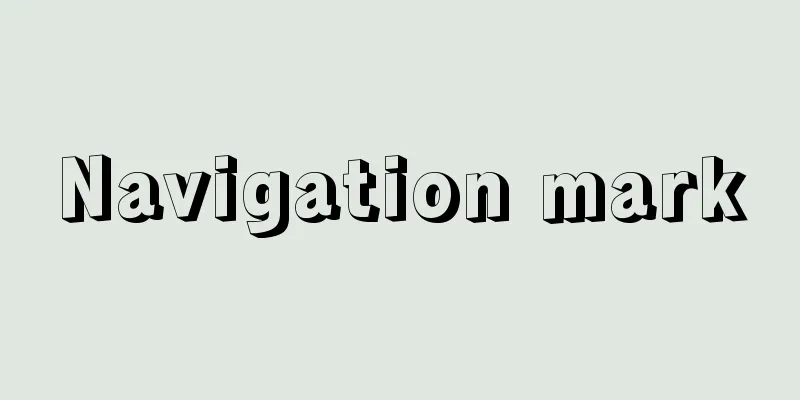Navigation mark

|
It refers to facilities that aid ship navigation using lights, shapes, colors, sounds, radio waves, etc. In Japan, according to the Navigation Aids Act, they are installed and managed by the Japan Coast Guard or those authorized by the Commissioner of the Agency. [Fumihiko Kawamoto] historyFor short voyages in shallow boats when visibility is good, natural landmarks such as mountain peaks, islands, and prominent trees (trees that are visible from the sea) are sufficient, but as ships get larger and their drafts deepen, sailing so far out that the shore is no longer visible, and sailing at night, day or night, they need artificial facilities to give the ship a way to confirm its position and to indicate the presence of obstacles and safe waterways. The origins of navigational markers date back as far as before Christ. In Japan, "mio tsukushi," which indicates a "mio," a deep waterway that ships can pass through, appears in the Manyoshu, and beacons (tobuhi) and lampstands (tomyodai) have been used as guides at night for over 1,200 years, and over 400 years, respectively. The first lighthouse similar to the current one was built in 1795 at Eddiston Lighthouse in Plymouth, England. The oldest lighthouses in Japan are those built in 1869 (Meiji 2) at Honmoku, Kannonzaki, and Nojimazaki in Yokohama. [Fumihiko Kawamoto] Modern navigational aids[1] By light, shape, and color. At night, they use a constant light, and during the day, they use shapes and colors to indicate positions, obstacles, and routes. There is a distinction between night beacons that have lighting devices and day beacons that do not, but it is customary for night beacons to have a structure that is effective as a daytime target. (1) Lighthouses, light poles, and landmarks: Structures installed on the coast as landmarks for ships to identify land, major turning points, or their position, or to indicate ports, harbors, and port entrances. There are tower-shaped lighthouses and pillar-shaped light poles that emit light, and landmarks that do not emit light. (2) Light beacons and beacons: Structures installed on reefs, shallows, etc. to indicate obstacles and navigation routes. There are light beacons that emit light and beacons that do not emit light. (3) Lighted buoys and buoys. Used for the same purpose as (2), these are floating structures secured to the seabed by weights or anchors. There are two types of lighted buoys: those that emit light and those that do not. (4) Leading lights and leading beacons: To indicate the route through difficult waterways or bay mouths, two or more are installed in pairs on land along the extension of the route. Those that emit light are called leading lights, and those that do not are called leading beacons. (5) Directional lights (4) are installed on land on the extension of the waterway for the same purpose. They indicate the waterway with a white light, the port danger side with a green light, and the starboard danger side with a red light. (6) Bridge lights: Lights installed on bridge girders, piers, etc. to indicate the center and side edges of the waterway or navigable waters under a bridge and the presence of bridge piers. There are center lights, side edge lights, and pier lights. (7) Illuminating light: A light that illuminates reefs, rocks, breakwaters, etc. to alert people to the presence of obstacles. (8) Other lights Lights indicating fixed structures installed on the sea, such as sea berths, wave observation towers, and oil drilling towers. In principle, night beacons are lit from sunset to sunrise, but unguarded and uncontrolled ones are often lit all the time. Even lighthouses with a guard may be lit during the day depending on the weather, such as fog. In ports and river mouths with few ships, there are also beacons that are lit only when ships are entering or leaving, and temporary lights that are lit only during certain seasons. Simple temporary lights are installed when a lighthouse is undergoing renovation. These navigational aids are identified by their lighting at night and by beacons or buoys during the day, and serve to direct navigational routes. [2] Acoustic: When visibility is poor due to fog or snow, a fog signal is a device that emits a sound to inform nearby ships of its location. Most fog signals are attached to lighthouses and other navigational aids. The sound is made by air sirens, motor sirens, earphones, diaphragm phones, fog bells, whistles, etc. The distance the sound travels varies depending on atmospheric conditions, topography, wind direction, etc., making it difficult to determine the direction of the sound source. [3] Radio-based signals include radio direction signal stations, Loran stations, Decca stations, and Omega stations. [4] Other Special navigational aids include the following: (1) Tidal Signal Station: A facility in a strait with strong tidal currents that notifies ships of changes in the direction and speed of tidal currents by using images, lights (electric sign), and radio waves. Tidal signal stations are installed in the Kurushima Strait and the Kanmon Strait. (2) Vessel Traffic Signal Stations: These are facilities that use radar and television cameras to collect information on vessel traffic on specific routes within the port and in nearby waters, and report this information to vessels by radio telephone at regular intervals and upon request, along with the control situation of specific routes. They are installed in Tokyo No. 13, Shiohama, and Honmoku (Kanagawa Prefecture). (3) Radar Station: A facility that uses radar to collect ship information within a port or in congested waters and reports it to ships by radio telephone at regular intervals or upon request. Radar stations are installed in Kushiro Port, Kannonzaki (Kanagawa Prefecture), and Osaka Port. (4) Ship Movement Signal Station: A facility that uses land-based radar installed on bridge piers to detect the presence of ships in an area where radar images of ships are obstructed by bridges and report the presence or absence of ships in the area using lights or radar beacons when visibility is poor. A signal station is installed on Omishima Bridge in the Seto Inland Sea. [Fumihiko Kawamoto] [References] | | | |©Shogakukan "> Examples of installation of navigation aids Source: Shogakukan Encyclopedia Nipponica About Encyclopedia Nipponica Information | Legend |
|
灯光、形象、彩色、音響、電波などを用いて船舶の航行を援助する施設をいう。日本では航路標識法によって、海上保安庁または同庁長官の許可を受けた者が設置・管理を行っている。 [川本文彦] 歴史底の浅い小舟で視界のよいときだけの小航海では、山頂、島、著樹(海上から見て顕著な樹木)などの自然目標だけでもよいが、船が大きくなり、喫水も深くなって、陸岸が見えなくなるほど遠くへ船を進め、昼夜を分かたず夜間も航海するようになると、船舶に位置を確認する手段を与え、障害物の存在や安全な水路を示す人為的施設が必要になる。航路標識の起源は遠く紀元前にさかのぼる。日本では、船の通行できる水深の深い水路である「みお」を示す「みおつくし」が『万葉集』に出てくるほか、烽(とぶひ)は1200年以上前、灯明(とうみょう)台は400年以上も前から夜の道しるべとして用いられてきた。 現状に近い灯台が初めて建設されたのは、1795年、イギリスのプリマス港のエジストン灯台である。日本では1869年(明治2)、横浜本牧(ほんもく)、観音(かんのん)崎、野島(のじま)崎につくられた灯台がもっとも古い。 [川本文彦] 現代の航路標識〔1〕灯光・形象・彩色によるもの (1)灯台・灯柱・陸標 船舶が陸地、主要変針点または船位を確認する際の目標として沿岸に設置されたり、港湾、港口等を示すために設けられた構造物。灯光を発し構造が塔状の灯台、柱状の灯柱と、灯光を発しない陸標がある。 (2)灯標・立標(りっぴょう) 障害物や航路を示すために岩礁、浅瀬などに設置した構造物で、灯光を発する灯標と、発しない立標がある。 (3)灯浮標(とうふひょう)・浮標 (2)と同じ目的で用いられるが、重りや錨(いかり)で海底に固定されて海上に浮かぶ構造物である。灯光を発する灯浮標と、発しない浮標とに分かれる。 (4)導灯・導標 通航の困難な水道や湾口などの航路を示すために、航路の延長線上の陸地に2基以上を1対として設置される。灯光を発するものを導灯、発しないものを導標という。 (5)指向灯 (4)と同じ目的で航路の延長線上の陸地に設置される。白光で航路を、緑光で左舷危険側を、紅光で右舷危険側を示す。 (6)橋梁(きょうりょう)灯 橋下の航路または可航水域の中央・側縁および橋脚の存在を示すために、橋桁(はしげた)、橋脚などに設置する灯光をいい、中央灯、側端灯、橋脚灯がある。 (7)照射灯 障害物の存在を知らせるため、暗礁、岩礁、防波堤先端などを照射する灯火。 (8)その他の灯光 シーバース、波浪観測塔、石油掘削塔など海上に設置された固定構造物を示す灯光。 夜標は原則として日没時から日の出時まで点灯されるが、無看守・無管制のものは常時点灯している場合も多い。また看守者のいる灯台でも、霧の発生など、天候によっては昼間から点灯されることがある。また出入船舶の少ない港湾や河口で、船舶出入時だけ点灯される標識や、季節を限って点灯される臨時灯もある。灯台改築中などには簡単な仮灯が設けられる。 これらの航路標識は、夜間は灯質、昼間は立標式・浮標式によって識別し、航路を指示する。 〔2〕音響によるもの 〔3〕電波によるもの 〔4〕その他 (1)潮流信号所 潮流の強い海峡において、潮流の流向・流速の変化を、形象、灯光(電光板)、電波で船舶に通報する施設。来島(くるしま)海峡、関門海峡に設置されている。 (2)船舶通航信号所 レーダー、テレビカメラにより、港内の特定航路やその付近の水域の船舶の交通情報を収集し、特定航路の管制状況とともに、定時および依頼に応じて無線電話で船舶に通報する施設。東京13号地、塩浜、本牧(神奈川県)に設置されている。 (3)レーダー局 レーダーにより港内または船舶の輻輳(ふくそう)する海域において、船舶情報を収集し、定時および依頼に応じて無線電話で船舶に通報する施設。釧路(くしろ)港、観音崎(神奈川県)、大阪港に設置されている。 (4)船舶動静信号所 橋梁が船舶のレーダー映像に障害を及ぼす海域で、視界不良時に橋脚に設置された陸上レーダーで、海域内の船舶の有無を検知し、灯光、またはレーダービーコンで通報する施設。瀬戸内海の大三島橋に設置されている。 [川本文彦] [参照項目] | | | |©Shogakukan"> 航路標識の設置例 出典 小学館 日本大百科全書(ニッポニカ)日本大百科全書(ニッポニカ)について 情報 | 凡例 |
Recommend
Casinum - Casinum
…Population: 34,590 (1990). In Roman times it was...
Blue Spotted Sea Snake - Blue Spotted Sea Snake
...After about five months, baby snakes with a to...
Nutrients - Nutrients
A general term for medicines taken to make up for ...
Weinberg, W.
...Research into natural and artificial mutations...
Allomorph
…In this way, morphemes can take different forms ...
Stump-tailed monkey
…An ugly Old World monkey of the Cercopithecidae ...
Equivalent - Toryo
A fixed amount assigned to each element or compou...
Campanula carpatica (English spelling) Campanula carpatica
… [Munemin Yanagi]. … *Some of the terminology th...
Yucca recurvifolia (English spelling) Yucca recurvifolia
… [Takabayashi Masatoshi]. … *Some of the termino...
Free church (English)
…This is due to the tradition of people persecute...
Early Christian Art
Art from the period of the establishment and deve...
Stomach X-ray examination
Roentgenography is an X-ray examination to examine...
Altiur - Altiur
...occupying the center of the grasslands north o...
Twenty-four eyes
A full-length novel by Tsuboi Sakae. It was seria...
Urupsou (English name) Lagotis glauca
A perennial plant of the family Leptaceae. It grow...


![Kamoto [town] - Kamo](/upload/images/67cb407ab32cb.webp)






